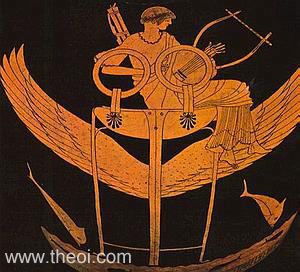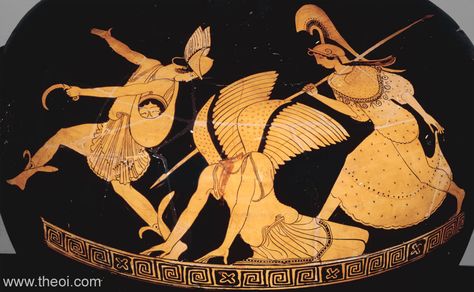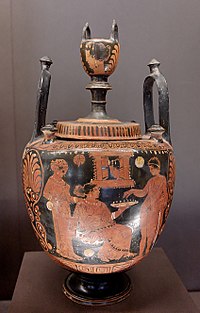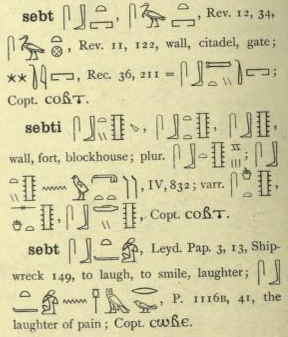| PART VII: | old Greece and parabolic mirrors, |
| Genesis and Mahabharata |
| content of page: first half: |
A] symbology in ancient Greece |
| second half: |
B] the same theme of the ‘sun birth’, the ‘smiling’ and ‘cherub’ of previous Mahabharata returns in Genesis |
A] the cauldron and mirrors in ancient Greece
1] Greece
| a) the cauldron of Apollo and Hestia Like Akkad stands to Sumerian, likewise Greece stands to ancient Egypt, in the sense that the egypt pantheon moved to Greece, but the Greek themes became often polluted from the original. However, a number of aspects are still solid enough to can identify — as the tripod of Apollo, pictured above, with wings below (perhaps as Shu feathers-axis), and Apollo himself sitting within the chalice; or as the priestesses does within his temple, to right. The deep archetype of a ‘tripod’, with a ‘chalice’ on top, adorned by ‘rings’, can hardly be else as relating to the present theme. That Apollo (representing the Ba-spirit) is sitting in the chalice, is similar to the Ba-soul within the ring in Tut’s basrelief; the chalice as glyph NEB-, and the attached ring-handles likely related to the cherub wheels. Strange enough, the chalice is both a ‘fire chalice’ (see Hestia, below), but the same time, in relation to Apollo, intended as a place to be seated upon, as dwelling-place. To right; the tripod was typically placed across a fissure in the mountain, where the intoxicating smoke would give ‘visions’ to the priestess being the oracle; and the relation with the fire-altars in the spells is obvious: where eden aspects are burned, and the mixture as smoke (glyph H’ET-) flows up and forms the an-face, north. |
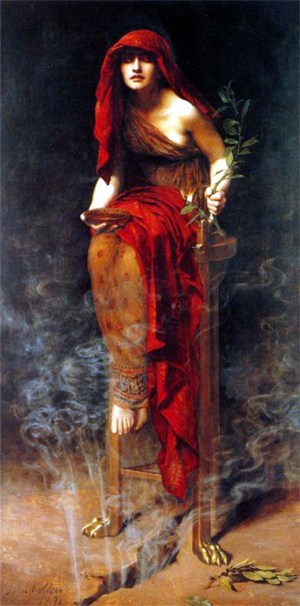 |
|
More difficult are the ‘three legs’; likely the same as the trishula from Vishnu [Anubis], to right, which is very similar to the “east” glyph ÁAB; the region of these three legs then being upón the tile (and perhaps as inversion of the cherub legs – but the triple-region above the tile is Vague to us, still), |
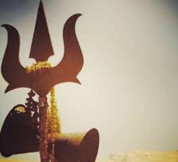 thepicta com |
as the later roman Vesta, Hestia is the equivalent of NEBTH’ET, ruling the chalice NEB-; as her name depicts in “hearth, fireplace, altar” of the oikos, “family, house” – literally Nebt-h’et. She prepared the fat-offerings to the gods on mt Olympos, where “fat” is glyph ÃT; and it is said Cronos swallowed her (and other children), then spat her out again – which is the same theme as we saw with the descent of Inanna, namely being south, then creating above the cube this solarplane and the Sekhet-fields as centre within it.
If ever the fire of her hearth became extinct, it was not allowed to be lighted again with ordinary fire, but either by fire produced by friction, or by burning glasses drawing fire from the sun. The mystical speculations of later times proceeded from tile simple ideas of the ancients, and assumed a sacred hearth not only in the centre of the earth, but even in that of the universe, and confounded Hestia in various ways with other divinities, such as Cybele, Gaea, Demeter, Persephone, and Artemis. (Orph. Hymn. 83; Plut. de Plac. Philos. 3, 11, Numa, 11.) [1]
…the interesting aspect is the “lightening by burning glasses” – which immediately reminds us to the possibility of them using the cherub wheel to create Rã by (being the ‘burning torch’), because this same method was used to light the olympic fire, using a parabolic mirror! This implies that the real ‘fire’ does not originate into the chalice itself – but is created as Rã, as ‘deflected fire’, from the original area of fire, namely the mirror as cherub wheel.
…we should address still Prometheus, a form of Cain,
who stole the fire, but time prevents us from making that link –
instead, we look at Perseus, as a form of Horus (Gilgamesh);
the ‘medusa’ representing the same type as the Humbaba in previous part,
“Athena, with whom Medusa had ventured to contend for the prize of beauty, first showed to Perseus the head of Gorgo in images, near the town of Diecterion in Samos, and advised him to be unconcerned about the two immortal Gorgons, Stheno and Euryale. Perseus then went first to the Graeae, the sisters of the Gorgons, took from them their one tooth and their one eye, and did not restore them to the Graeae until they showed him the way to the nymphs; or he cast the tooth and the eye into lake Triton, so that the Graeae were no longer able to guard the Gorgons (Hygin.Poet. Astr. ii. 12). The nymphs provided Perseus with winged sandals, a bag, and the helmet of Hades, which rendered him invisible, Hermes with a sickle, and Athena with a mirror (Hes. Scut. Her. 220, 222; Eurip. Elect. 460; Anthol. Palat. ix. 557; comp. Hygin. Poet. Astr. ii. 12; Theon, ad Arat. p. 29). Being thus armed, he went to the Gorgons, who dwelt near Tartarus on the coast of the Ocean, whose heads were covered, like those of serpents, with scales, and who had large tusks like boars, brazen hands, and golden wings. He found them asleep, and cut off the head of Medusa, looking at her figure
through the mirror, for a look at the monster herself would have changed him
into stone. Perseus put her head into the bag which he carried on his back,
and as he went away, he was pursued by the winged Gorgons (Hes. Scut. Here. 230; Paus. v. 118. § 1) [1]
pinterest
To know the position of the Medusa, we need to know what she is nót –
in a related story, the hero Hercules (Osiris) killed the Hydra,
a monster with multiple serpentheads, representing the Watercourse
(the monster dwelt near a ‘well’, and was the offspring of the uraei
Typhon and Ekhidna, aka Adam and Eve).
Where the Hydra had manifold snake-heads, also Medusa has serpentine
locks of hair, and the “deadly look” is similar to the described
‘evil stare’ we saw by Humbaba. Originally, Homer related about but
one Gorgon, it’s name as “fierce, terrible”, but later three gorgones
were depicted, of which Medusa was the half-human main one.
The Gorgones are described (Scut. Here.233) as girded with serpents, raising their heads, vibrating tongues, and gnashing their teeth; Aeschylus (Prom.794. &c., Choëph. 1050) adds that they had wings and brazen claws, and enormous teeth. On the chest of Cypselus they were likewise represented
with wings. [2]
The symbology combines several true and made-up aspects of the cherubs,
pushed together into one cluster-image, with as main feature the ‘head’
and the ‘speech of the head’ (vibrating tongues, teeth as sharp words
of speech, etc). But the original of these archetypes had wandered so
far astray for the old Greeks, that
Pliny (H. N. iv. 31) thought that they were a race of savage, swift, and hair-covered women; and Diodorus (iii. 55) regards them as a race of women inhabiting the western parts of Libya, who had been extirpated by Heracles in traveling Libya. [1]
| In the Perseus story, there occurs an equal mixup: he first travels to the Graeae, “the old women”, as two (or three) old hags, who shared together but one eye, and by stealing the eye from them, he now knows where the head is located. He then continues to the Gorgones, and slays the head. The symbolism shows that he first steals the cherub wheel, in order to can make the head (upper node) to go Dark: because the same ‘leather bag’ returns in this story, as well as the sandals which Gilgamesh presented.
Interesting is the “mirror of Athena” (egyptian Neith), probably her shield she supplied to him – but used as mirror here, showing “through the inversion of the wheel (!), he could cut-off the head of Medusa”. To upper right, another depiction of a Gorgon; note the dome around the head and the protruding tongue – which is a very unusual theme for ancient Greece, yet returns in many depictions of meso-america, next section. |
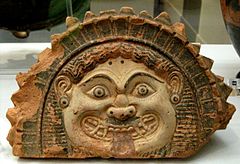
|
d) the sandal of Hermes
Above, a roman copy in the Louvre from the lost Greek original of ‘Hermes fastening his sandal’, the theme being very popular in Greece around the fourth century BC; but we are interested in the archetypes – Hermes being a version of Thoth (where Dionysus was the nature of Thoth), the ‘sandal’ representing the solarplane as the binary, below. We can argue that his positioning is absolutely logical, but the standing of the foot upon a mountain, and Hermes representing the perch-region of Thoth, can explain why this depiction became so popular – for subconscious reasons then, ofcourse.
B] restoring the cherub – book of Genesis
As we saw by now, the Vedic uses often ‘names’ to describe an aspect or construct, just as scripture does. The major difference is, that scripture intertwines all the names with a living adamite soul, as in a ‘playout’, in real-time events; and this entire playout, until this very moment, starts anew with the person of Abraham. The term “using souls” is not intended negative – but since it was the adamite soul hersélf who gave away all (at the fall), it is also the soul who will have to win all the aspects back: but since the soul is blind and helpless, these ‘playouts’ make that the soul, even without understanding his appointed theme (and often unwillingly) still ‘cooperates’ into acquiring that specific legal right.
1) the restart after the deluge:
the covenant with Abraham
We addressed already what was the city UR-;
Abraham is picked to become ‘the father of nations’, implying that
Sara will attain the role of Eve, and so on. A curious narrative
is about the covenant about to be made between God and Abraham,
that is, with the adamite soul –
Gen.15 and·he-is-taking for·him all-of these and·he-is-sundering·them in·the·midst and·he-is-giving each sundered-part-of·him to·to-meet-of associate-of·him and the·bird not he-sundered and·he-is-descending the·bird-of-prey on the·cadavers and·he-is-turning-back·them Abram and·he-is-becoming the·sun to·to-set-of and·stupor she-fell on Abram and·behold! dread darkness great falling on·him and·he-is-saying to·Abram to-know you-are-knowing that sojourner he-shall-become seed-of·you in·land not to·them and·they-serve·them and·they-humiliate·them four-of hundreds year and·generation fourth they-shall-return hither that not repaid depravity-of the·Amorite unto hither and·he-is-becoming the·sun she-set and·twilight he-became and·behold! stove-of smoke and·torch-of fire which he-passed between the·severed-parts the·these in·the·day the·he he-cut ieue with Abram covenant closing – 2) Abraham and the sacrifice related to Isaac Gen. 22 and·he-is-saying take-you! please! son-of·you only-one-of·you whom you-love Isaac and·go-you! for·you to land-of the·Moriah and·offer-up-you·him! thereole for·ascent-offering on one-of the·mountains which I-shall-say to·you
and·he-is-saying to·him take-you! for·me heifer being-three-years-old and·goat being-three-years-old and·ram being-three-years-old and·turtledove and·fledgling
*** but the used word for ‘heifer’ returns in relation with Moab (see Lyre part) and Egypt, and once as cherubs-related, in the line “and their soles were like the sole of a calf’s foot”, Ez.1:7; rendering indeed the ‘badger theme of shoes’ valid. The problem however is, that all four cherubs have “hooves as calves”, (glyph uHem-, “to renew – by hebrew-H”), yet the other three cherubs were “man-like, a bird and a lion”, then we must assume that the bull-cherub represents “the connection between the south-land and the dimension north”, and is probably the reason why they wanted the bull.
who represented all of théir aspects [ram, goat] but in a combined form as ‘bull’.
And he took unto him all these, and divided them in the midst, and laid each piece one against another: but the birds divided he not
And when the fowls came down upon the carcases, Abram drove them away
And when the sun was going down, a deep sleep fell upon Abram; and, lo, an horror of great darkness fell upon him
And he said unto Abram, Know of a surety that thy seed shall be a stranger in a land [that is] not theirs, and shall serve them; and they shall afflict them four hundred years
Seen like this, the hebrew peoples made the ‘playout’ for all of the adamite souls until this moment; where the exodus was the playout of ‘escaping this matrix’;
But in the fourth generation they shall come hither again: for the iniquity of the Amorites [is] not yet full
the Amorite are related to the great pillar,”Amorite, whose height was like the height of cedars, and he was strong as the oaks;
yet I destroyed his fruits from above, and his roots from beneath”, Amos 2; the ‘cedar’ as glyph ÃSH-; the iniquity of the pillar-construct must sicken-on a few thousand years more still, since Abraham,
And it came to pass, that, when the sun went down, and it was dark, behold a smoking furnace, and a burning lamp that passed between those pieces
the end of the solarplane era, and in context, it makes sense that now indeed this sun is setting;
in the above reconstruction there still can be improvements –
but the context must be Valid; we are careful not to overdo it,
nor try make scripture fit according to other writings, but this
particular story makes absolute Sense when the right symbology can be applied —
do you wonder still whý spells and vedas have been so poorly ‘translated’..?
– we have to switch the events a bit for context:
after the previous scene of establishing the covenant,
should come the story of Sarah, Hagar and the birth of Isaac; but because the context of the sacrifice upon the mountain links with part 1, we go there first –
and·he-is-becoming after the·things the·these and·the·Elohim he-probed Abraham and·he-is-saying to·him Abraham and·he-is-saying behold·me!
And it came to pass after these things, that God did tempt Abraham, and said unto him, Abraham: and he said, Behold, [here] I [am].
And he said, Take now thy son, thine only [son] Isaac, whom thou lovest, and get thee into the land of Moriah; and offer him there for a burnt offering upon one of the mountains which I will tell thee
[continued, line 11] and·he-is-calling to·him messenger-of ieue from the·heavens and·he-is-saying Abraham and·he-is-saying behold·me!
הַ מֹּ רִ יָּה e·mrie the·Moriah, is the version here;
but in the only other occurrence it is
הַ מּ רִ יָּה e·murie the·Moriah; where the VaV is added inbetween (the -U);
the second version is from 2 Chronicles 3, where Solomon starts building the temple on the mount e-murie; that the VaV is added here (as the halfstaff-T-e) shows this mountain represents the tziun-mountain, as opposed to the mountain north (see diagram page). The rather curious prefix “the (mrie)” must be similar to “he-the”, see last line in this chapter;
possible roots: (masculine noun) ‘mor’, as “myrrh” (and by extension, ‘bitter’);
as glyph ÃNT, “the lights / (of) place-T / (for) existence / (of) willpower”, immediately turning into ÃNT’T-morningboat, stealing;
‘mor’ and ‘mur’, “to change, exchange, alter”, but note the inserted -U this time;
‘mara’ and the derivative ‘meri’ , “rebellious”;
…while the “ra’a” is “sight, seeing”, into ‘mirror’ and ‘seer, vision’ etc; glyph MAA-, “(reaped-) Sight”; it is a large cluster of possible combinations, but contextually many apply here: for instance, a possible term for the mountain north could be “the rebellious (existence of) Sight”; while for the Tziun mountain (presently) “the (bittered) myrrh of Sight”, etc; but the term ‘exchange’ must be quite important in this cluster;
and·he-is-saying Abraham Elohim he-shall-see for·him the·flockling for·ascent-offering
And the angel of the LORD called unto him out of heaven, and said, Abraham, Abraham: and he said, Here [am] I.
and·he-is-saying must-not-be you-are-stretching-forth hand-of·you to the·lad and·must-not-be you-are-doing to·him anything that now I-know that fearing-one-of Elohim you and·not you-kept-back son-of·you only-one-of·you from·me
And he said, Lay not thine hand upon the lad, neither do thou any thing unto him: for now I know that thou fearest God, seeing thou hast not withheld thy son, thine only [son] from me.
- perhaps the strangest line in this event: why was it necessary that Abraham had to be willing to sacrifice..?
If Abraham represented Adam, and he was, inwardly, ready to cut-off [Isaac], then what he actually cut-off..? was the playout here, the adamite soul killing his only son —- as later God would have His only Son to be killed?
….and perhaps ‘the intent (Abraham showed)’ was “acceptable enough”, concerning the adamite soul?
Some events have a metaphysical fractal we simply fail to even imagine…. - perhaps a clue to the above is the line “that you fear the godhead”; implying that Abraham, as adamite soul, must have had a terrible fight in his own soul, to make a free-choice decision to slay his son (perhaps even toughened by the voices of the elohim) – this was the playout he had to do
and·he-is-lifting Abraham eyes-of·him and·he-is-seeing and·behold! ram behind being-held in·the·thicket in·horns-of·him and·he-is-going Abraham and·he-is-taking the·ram and·he-is-offering-up·him for·ascent-offering instead-of son-of·him
And Abraham lifted up his eyes, and looked, and behold behind [him] a ram caught in a thicket by his horns: and Abraham went and took the ram, and offered him up for a burnt offering in the stead of his son
- the ram, as only one time used, from H193, “to roll” (perhaps as it’s horns);
the note adds ” also belly, abdomen” (related to roundness); and the usual ‘strength, power, etc”, the ram is dualism (and part of the cherub), but here related to ‘belly’ KHAT, and “his horns were entwined in a shrub”, - ‘caught’, yet the colour of the used term is “to seize”, deliberately, “to take, to hold” (as active), see next,
- the ‘thicket’ as “branches”, but the thicket itself representing “to weave, to interweave”, there must be a relation between the use of “thicket” in the Rig Veda, always related to ‘forest’; the “lines on Humababa’s head”, and the Aztec depiction of the tree [and perhaps even the SA-glyph], perhaps as the ‘bud’ within the lampstand [as complex flower-bud; compare the Jeremia page about the ‘sour grape being cut-off the bud’], so instead of Abraham sacrificing his promised son – read, as the redeemed adamite soul – he sacrifices the matrix Dualism, in the form of a ram, having deliberately entwined itself with Eden’s trees within the lampstand;
and·he-is-calling Abraham name-of the·place the·he ieue he-shall-see which he-is-being-said the·day in·mountain-of ieue Yahweh he-shall-be-seen
And Abraham called the name of that place Jehovahjireh: as it is said [to] this day, In the mount of the LORD it shall be seen.
- the line cannot be “as it is said to this day”: that would rape the metaphysical nature of this event (as if that would be the importance to add, that until today the mountain is called like that); but more like “God’s (type of) Sight”, as opposed to MAA-; the prefix ‘he-the’ shows it is “an attribute” óf God.H3070 has ‘jehovahjireh’, ” jehovah will see to [it]”, which is ofcourse possible (apart from the ‘jehovah’), but doesn’t take into account the war between the rebellious-Sight (MAA-) and Eden’s.
————– end 2
3) birth of Isaac and the ‘laughing’
One step back in time to the previous, as the events leading
up to the birth of Isaac; the names of both Abram and Sarai
get a bit adapted – into Abraham and Sarah. She, representing Eve,
bore the name as root SR, “princess, ruless, etc”, but from Akkadian
śararu, ‘to rise in splendour (as the sun)’; linked to the story of
‘birthing the Rã sun’ — and this title became altered in root SRH.
Just as in the Moriah situation, also here was added one letter,
and the new root appearing but one other time, in Isaiah 9:6,
“.. and the government will be upon His shoulders” —
implying here, that “the government of Eve will be restored”,
It does not tell outright that “eden feminine will rule again”,
yet it dóes, in a certain way: compare how to the man Adam is said
“you will follow your woman”, as the ‘rule by love’, sustained
by abolute (will-) power. What they did, is “steal the power”
(glyph -Ã), rendering “the love” aspect helpless and defenseless.
But the moment this masculine (will-) power will be restored and
coupled with the “love nature”, Eden will start again.
This time nót to be separated, anymore.
Abraham and Sarah had no children,
so his wife thought to make the servantgirl Hagar bear her a son;
but after she got pregnant from Abraham, she starts looking down
on Sarah, and Sarah chases her out. She flees to a region between
palestine and egypt, sitting near a well – the name ‘Hagar’ having
a foreign root (non-hebrew), and it is even stated “she was an
egyptian woman”, sic. The possibilities are very limited, per glyphs
(and one Ha-ga appears literally), so her name must be a composite (glyph);
perhaps existing of HA- “descended hebrew-H” and GA-, the throne-G.
Gen.16
and·he-is-finding·her messenger-of ieue Yahweh on spring-of the·waters in·the·wilderness on the·spring in·way-of Shur
And the angel of the LORD found her by a fountain of water in the wilderness, by the fountain in the way to Shur
- Shur perhaps being today’s Suez, between palestine and Egypt; Shur’ as “wall”
the wall can be “Ptah’s fortress in the south”,
on·so he-called to·the·well Bar~Lechi~Rai behold! between Kadesh and·between Bered
Wherefore the well was called Beerlahairoi; behold, [it is] between Kadesh and Bered
- *roi, H7203 ro’eh, “seer, a vision”, from ‘to see’,
*lahai, ‘life, to give life’;
*be’er, root “to engrave, to make plain”,
likely “to engrave the life of Sight”, the engraving a reference to Pteh’ ofcourse, the ‘sight’ being eden’s; - situated between Qadesh, ‘holy’ but only in human notion, as presenting this body to be clean”; *bered, as ‘hail’; with the curious note that “hail (wholeness) deriving from literal hail”; once used in Isaiah, “..when it shall hail, coming down on the forest, and the city shall be low in a low place”. The ‘city’ being the place of Õn, and ‘forest’ is the typical theme of the Vedas (see the posted Mahabharata), as the region in top of the lampstand (and tile), compare the “shrubs” in part 2); this “hail (storm)” as Eden’s, being encircled, in glyphs as SHENÁ, “the hail(storm) of hail to encircle”, so “the engraving site” is located between “presenting physical holiness” and “real hail”, as the return of eden, and, remembering the tile Pteh’ stands upon, the whole line, entirely, can read,
“the engraved life of Sight,/(between) physical holiness and hail”, related to Ishmael’s character,
Next, the boy Ishmael is born –
but the problem with this name is actually a problem of context – the root “shema” can be “the act of hearing”, “hearing something through the grapevine”, “observant listening”, “understanding someone’s language”, “hear someone out” or “hear someone in a judicial setting” or “to hear – and forgive, or help”. The reason for the name is given – namely “that God heared thy affliction”, yet the term should relate to the next declaration, that ‘though he will become a multitude, he will have the character of a stubborn donkey’. For some reason, we choose the “hear someone in a judicial setting”.
– the term ‘wild ass’ (said for reason ‘to be swift’) has as root H6500, “to be fruitful”, but the relation is unclear. The latter term returns in a description about “the well of Ephraim drying up”, which must relate to a foul well which makes him often to wander-astray – and we think it is related to a phallic aspect (energy). The “fruitful” could relate to this phallic-aspect, as well as the ‘donkey’; the male genitals being liked to ‘those of asses’ (the two whores chapter in Ezekiel), altogether perhaps describing “the nature of fallen adam, ruled by the flesh”. It may be no coincidence that He enters the city, ‘sitting upon a donkey’, that is, ‘ruling’.
In context, ‘Ishmael’ may represent “the multitude (as per Revelation)”, that is ‘all the heathen nations’, the term ‘heathen’ as opposed to “everyone who believes in Him”. Factually, it is said to Hágar that ‘thy seed will be numerous’, she being of egyptian nature (since it’s a playout), but ‘infused’ by another, resulting in Ishmael, who represents all adamite souls, caught in this flesh, but “who will ultimately hear upon El”, But we have to go back one step —- the moment when Abraham is told that Sarah herself will have a son,
and·he-is-falling Abraham on faces-of·him and·he-is-laughing and·he-is-saying in·heart-of·him·? to·son-of hundred year he-shall-be-born and·if Sarah·daughter-of ninety year she-shall-give-birth
Then Abraham fell upon his face, and laughed, and said in his heart, Shall [a child] be born unto him that is an hundred years old? and shall Sarah, that is ninety years old, bear?
|
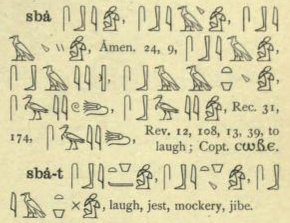
|
 |
|
The queen of the south represented here as “the Watercourse”, from H7651 sheba, as “the seven torches inbetween the cherubs”, “the seven candlesticks” in Revelation [which was foretold in Ze.2, ” for they shall rejoice, and shall see the plummet (q-axis) in the hand (executive region, tile) of Zerubbabel (Christ) with those seven — they are the eyes of the Lord, which run to and fro through the whole earth”].
to right, another SBÁ; Sebá; shown as either prisoners, staffs or as lights; we met the glyph in several spells, but since we now can relate these to the torches, we can try read the context better next time we meet this glyph.
the ‘seven lambs at the well’
Gen.21
and·he-corrected Abraham Abimelech on cases-of well-of the·waters which they-snatched servants-of Abimelech
And Abraham reproved Abimelech because of a well of water, which Abimelech’s servants had violently taken away
|
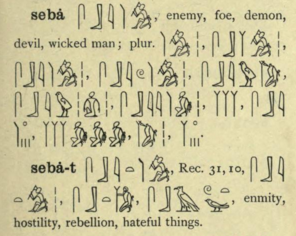 |
| Abraham pays off the man with cattle, they making a covenant; then, and·he-is-stationing Abraham seven ewe-lambs-of the·flock to·alone-of·them and·he-is-saying Abimelech to Abraham what? they seven ewe-lambs the·these which you-stationed to·alone-of·them And Abraham set seven ewe lambs of the flock by themselves. And Abimelech said unto Abraham, What [mean] these seven ewe lambs which thou hast set by themselves? |
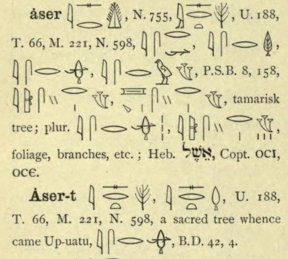 |
and·he-is-saying that seven ewe-lambs you-are-taking from·hand-of·me in·order-to you-shall-become to·me to·testimony that I-delved the·well the·this on·so he-called to·the·place the·he Beer~Sheba
And he said, For [these] seven ewe lambs shalt thou take of my hand, that they may be a witness unto me, that I have digged this well, wherefore he called that place Beersheba
- you can’t make it up: “these seven lambs thou take out of my hand”!
- be’er sheba, “the 7-fold-well“, note again the prefix ‘the-he’ (compare the-he-ieue-he-shall-see, above );
and·he-is-planting tamarisk in·Beer~Sheba and·he-is-calling there in·name-of ieue El-of eon
And [Abraham] planted a grove in Beersheba, and called there on the name of the LORD, the everlasting God
- note the juxtaposition between IEUE and El here,
- tamarisk, H815, here as ‘grove’ (by extention) – the grove perhaps being the ‘thicket’ in which the ram entangled;
to right, as glyph ÁSER, almost similar to H815 ãshel, but the glyphs dont use the -L;
“the flowers (=words) / (of) the mouth \\ (by) the workplace”,
“the branch (for the kh-house) / (for) the speech / (by) the workplace”,
“the tree (at) place-T / (for) speech / (by) the workplace”,
and, quite literally, “the root of Osiris” as ÁSAR
Perhaps, from this tree-branch onwards, come many of their trees as ÁMM, BEQ, ÃSH, etc.; an important note for us is that this tree may be the KHET-, see next part;
closing:
we will stop with Abraham — because we consider the point having been made, and it is Valid enough now; but from here on we need to focus upon this region, and keep it in mind when doing every next spell –
NEXT: rings and mirrors

